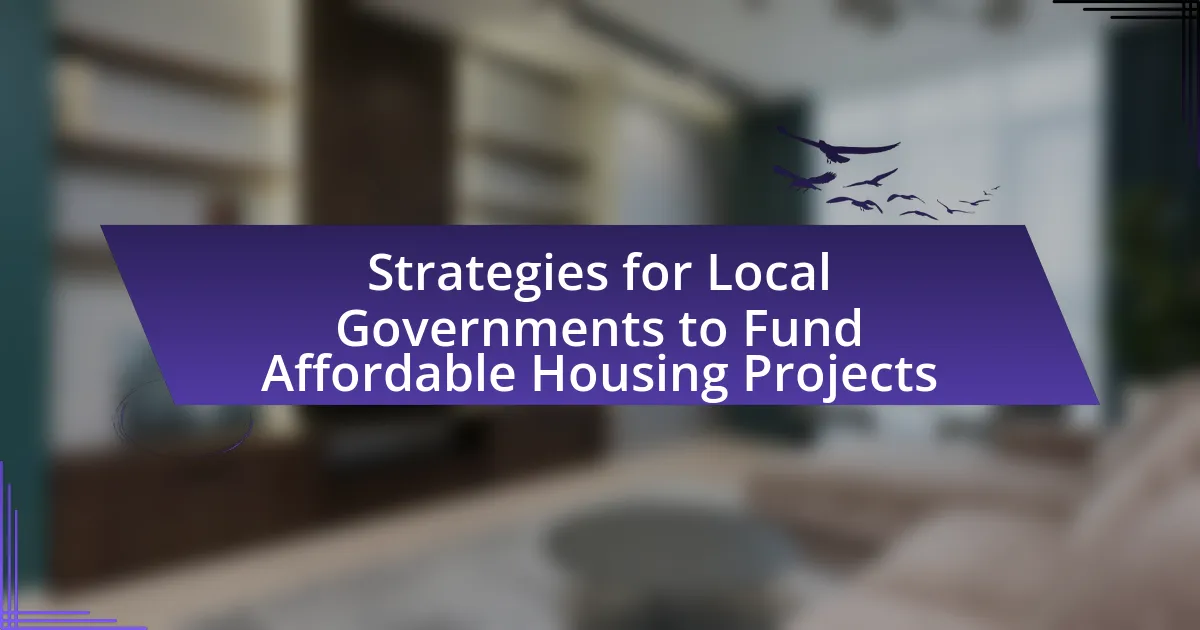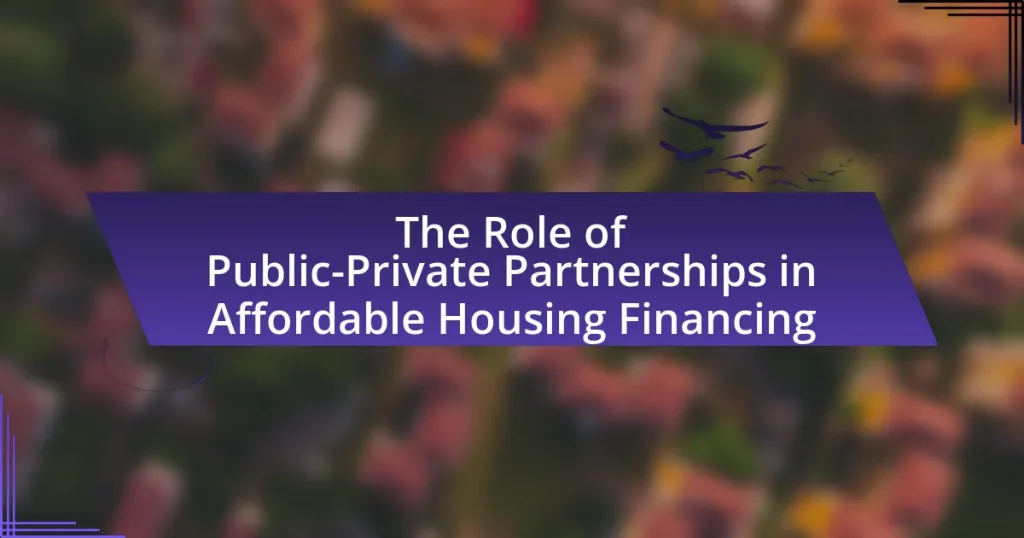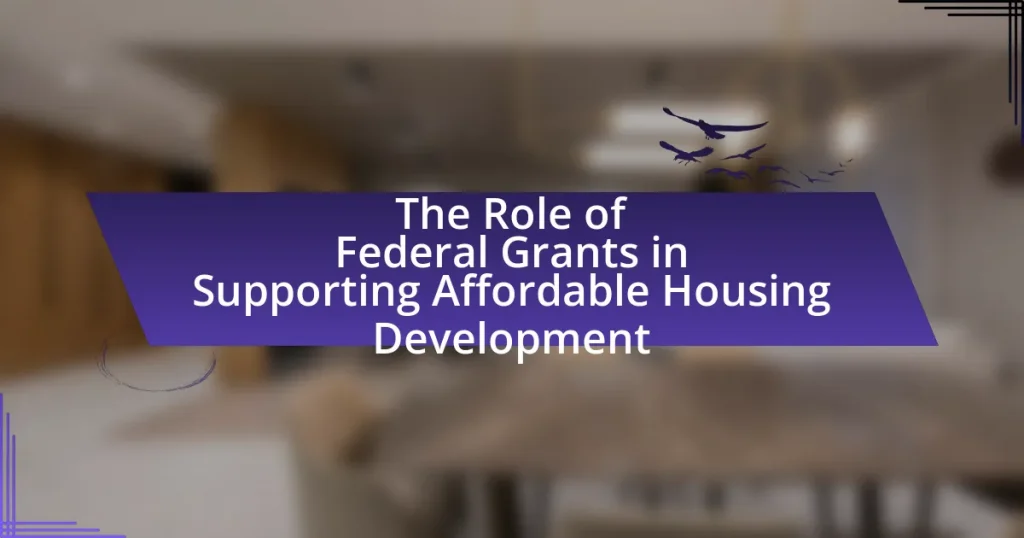Local governments play a crucial role in funding affordable housing projects through various strategies, including federal and state grants, inclusionary zoning policies, and public-private partnerships. They identify funding needs by assessing community housing demands and demographic trends, while factors such as project location, construction costs, and regulatory environments influence funding requirements. The article explores available funding sources, innovative financing mechanisms, and the importance of community engagement in the funding process. Additionally, it addresses challenges local governments face, such as limited financial resources and regulatory constraints, and offers best practices for enhancing funding success through collaboration and strategic planning.

What are the key strategies for local governments to fund affordable housing projects?
Local governments can fund affordable housing projects through several key strategies, including leveraging federal and state grants, implementing inclusionary zoning policies, and establishing public-private partnerships. Federal and state grants provide essential financial resources; for instance, the U.S. Department of Housing and Urban Development allocates billions annually to support affordable housing initiatives. Inclusionary zoning policies require developers to include a percentage of affordable units in new developments, effectively increasing the stock of affordable housing without direct government expenditure. Public-private partnerships enable local governments to collaborate with private developers, sharing costs and risks while accessing additional funding sources. These strategies collectively enhance the capacity of local governments to address affordable housing shortages effectively.
How do local governments identify funding needs for affordable housing?
Local governments identify funding needs for affordable housing through comprehensive assessments of community housing demands, demographic trends, and existing housing stock. They analyze data from sources such as the U.S. Census Bureau and local housing authorities to determine the number of low-income households and the gap between available affordable units and the demand. Additionally, local governments often conduct surveys and engage with community stakeholders to gather insights on housing challenges and priorities. This data-driven approach enables them to quantify funding requirements and prioritize projects that address the most pressing needs in their communities.
What factors influence the funding requirements for affordable housing projects?
Funding requirements for affordable housing projects are influenced by factors such as project location, construction costs, regulatory environment, and available financing options. Project location affects land prices and demand for housing, while construction costs can vary based on materials and labor availability. The regulatory environment, including zoning laws and building codes, can impose additional costs or constraints. Additionally, the availability of financing options, such as grants, low-interest loans, and tax credits, directly impacts the overall funding needed. For instance, the National Low Income Housing Coalition reports that the lack of affordable housing is exacerbated by rising construction costs and limited public funding sources, highlighting the critical interplay of these factors in determining funding requirements.
How can local governments assess community housing needs?
Local governments can assess community housing needs by conducting comprehensive housing studies that analyze demographic data, housing stock, and economic conditions. These studies often include surveys and public consultations to gather input from residents about their housing experiences and needs. For instance, the U.S. Department of Housing and Urban Development recommends using data from the American Community Survey to identify trends in housing affordability and availability. Additionally, local governments can collaborate with regional planning agencies to evaluate housing demand and supply dynamics, ensuring that assessments are grounded in current market conditions. This approach allows for a data-driven understanding of community housing needs, facilitating informed decision-making for affordable housing initiatives.
What funding sources are available for local governments?
Local governments have access to various funding sources, including federal grants, state funding programs, local taxes, and public-private partnerships. Federal grants, such as those from the U.S. Department of Housing and Urban Development, provide financial assistance specifically for housing projects. State funding programs often allocate resources for affordable housing initiatives, while local taxes, including property taxes and sales taxes, can be directed towards housing projects. Public-private partnerships leverage private investment to enhance funding capabilities for local government housing initiatives. These funding sources are essential for supporting affordable housing projects and addressing community needs.
What role do federal and state grants play in funding affordable housing?
Federal and state grants are crucial in funding affordable housing by providing financial resources that support the development and maintenance of low-income housing projects. These grants, such as those from the U.S. Department of Housing and Urban Development (HUD) and various state housing finance agencies, enable local governments to leverage additional funding, reduce construction costs, and lower the financial burden on developers. For instance, in 2021, HUD allocated over $10 billion in grants to support affordable housing initiatives, demonstrating the significant impact of these funds on increasing housing availability for low-income families.
How can local governments leverage private investments for housing projects?
Local governments can leverage private investments for housing projects by creating public-private partnerships (PPPs) that incentivize developers through tax breaks, streamlined permitting processes, and access to public land. These strategies encourage private entities to invest in affordable housing by reducing their financial risks and increasing potential returns. For instance, cities like San Diego have successfully utilized PPPs to fund housing developments, resulting in the construction of thousands of affordable units while sharing costs and responsibilities with private investors.
What innovative financing mechanisms can be utilized?
Innovative financing mechanisms that can be utilized include social impact bonds, community land trusts, and tax increment financing. Social impact bonds allow private investors to fund social programs, with returns based on the achievement of specific outcomes, thus incentivizing effective solutions for affordable housing. Community land trusts enable communities to collectively own land, reducing speculation and keeping housing affordable. Tax increment financing captures future tax benefits generated by new developments to fund infrastructure improvements, directly supporting affordable housing initiatives. These mechanisms have been successfully implemented in various cities, demonstrating their effectiveness in addressing housing challenges.
How do public-private partnerships enhance funding opportunities?
Public-private partnerships enhance funding opportunities by leveraging resources and expertise from both sectors to finance affordable housing projects. These collaborations allow local governments to access private capital, which can significantly increase the available funding pool. For instance, a study by the Urban Institute found that public-private partnerships can reduce project costs by up to 30% through shared risks and efficiencies. Additionally, these partnerships often attract federal and state funding, as they demonstrate a commitment to collaborative solutions in addressing housing shortages.
What is the impact of social impact bonds on affordable housing funding?
Social impact bonds (SIBs) significantly enhance funding for affordable housing by attracting private investment to address social issues. These financial instruments allow local governments to partner with private investors who fund housing projects upfront, with returns contingent on achieving specific social outcomes, such as reduced homelessness or improved housing stability. For instance, the Social Impact Partnership Act in the United States has facilitated projects that leverage SIBs to finance affordable housing initiatives, demonstrating their effectiveness in mobilizing resources. Research indicates that SIBs can lead to increased funding availability, as evidenced by the $100 million allocated for affordable housing projects in various pilot programs across the country, showcasing their potential to transform funding landscapes for local governments.

How can local governments effectively implement these funding strategies?
Local governments can effectively implement funding strategies for affordable housing projects by establishing dedicated funding sources, such as housing trust funds, and leveraging public-private partnerships. Housing trust funds provide a stable revenue stream, often funded through dedicated taxes or fees, which can be allocated specifically for affordable housing initiatives. Public-private partnerships enable local governments to collaborate with private developers, sharing resources and risks, which can lead to innovative financing solutions and increased project viability. For instance, cities like San Francisco have successfully utilized these strategies, resulting in the creation of thousands of affordable housing units.
What steps should local governments take to develop a funding strategy?
Local governments should conduct a comprehensive needs assessment to develop a funding strategy for affordable housing projects. This assessment identifies the specific housing needs within the community, including the number of affordable units required and the demographics of those in need. Following the assessment, local governments should explore diverse funding sources such as federal grants, state funding programs, and public-private partnerships. For instance, the U.S. Department of Housing and Urban Development (HUD) offers various funding opportunities that local governments can leverage. Additionally, establishing a dedicated housing trust fund can provide a stable revenue stream for affordable housing initiatives. Evidence from the National Low Income Housing Coalition indicates that communities with dedicated funding sources are more successful in meeting their affordable housing goals. Finally, local governments should engage stakeholders, including community organizations and residents, to ensure the funding strategy aligns with community priorities and fosters collaboration.
How can local governments prioritize projects based on funding availability?
Local governments can prioritize projects based on funding availability by conducting a thorough assessment of community needs and aligning them with available financial resources. This involves evaluating potential projects through a cost-benefit analysis, which quantifies the expected outcomes against the required investment. For instance, a study by the National League of Cities indicates that prioritizing projects with the highest social impact and lowest cost can lead to more effective use of limited funds. Additionally, local governments can leverage data from previous funding cycles to identify successful projects that maximized funding efficiency, ensuring that future allocations are directed toward initiatives with proven results.
What role does community engagement play in the funding process?
Community engagement plays a critical role in the funding process for affordable housing projects by fostering trust and collaboration between local governments and residents. Engaged communities are more likely to support funding initiatives, as they feel their needs and concerns are being addressed. Research indicates that projects with strong community involvement often secure higher levels of funding, as stakeholders are more willing to invest in initiatives that reflect local priorities. For instance, a study by the Urban Institute found that community-driven projects received 30% more funding than those developed without resident input, highlighting the financial benefits of inclusive engagement strategies.
How can local governments measure the success of their funding strategies?
Local governments can measure the success of their funding strategies by evaluating key performance indicators (KPIs) such as the number of affordable housing units created, the reduction in homelessness rates, and the level of community satisfaction with housing initiatives. For instance, a study by the Urban Institute found that cities that tracked these metrics were able to assess the effectiveness of their funding allocations and make data-driven adjustments to their strategies. Additionally, analyzing cost-effectiveness by comparing the amount of funding spent per unit of affordable housing developed can provide insights into the efficiency of funding strategies.
What metrics should be used to evaluate funding effectiveness?
To evaluate funding effectiveness for affordable housing projects, key metrics include return on investment (ROI), cost per unit, occupancy rates, and social impact assessments. ROI measures the financial return relative to the investment made, providing insight into the economic viability of the funding. Cost per unit assesses the total expenditure divided by the number of housing units created, allowing for comparison across different projects. Occupancy rates indicate the success of the project in attracting residents, reflecting demand and sustainability. Social impact assessments evaluate the broader effects on the community, such as improvements in quality of life and economic mobility. These metrics collectively provide a comprehensive view of funding effectiveness in achieving affordable housing goals.
How can feedback from stakeholders improve future funding strategies?
Feedback from stakeholders can significantly enhance future funding strategies by providing insights into community needs and preferences. Engaging stakeholders, such as residents, local businesses, and non-profit organizations, allows local governments to identify gaps in current funding approaches and prioritize projects that align with community interests. For instance, a study by the Urban Institute found that stakeholder engagement in housing policy led to more effective allocation of resources, resulting in a 20% increase in project approval rates. This evidence demonstrates that incorporating stakeholder feedback not only fosters transparency but also increases the likelihood of securing funding by ensuring that proposed projects resonate with the community’s priorities.

What challenges do local governments face in funding affordable housing projects?
Local governments face significant challenges in funding affordable housing projects, primarily due to limited financial resources and competing budget priorities. Many local governments operate under strict budget constraints, which often prioritize essential services like public safety and infrastructure over housing initiatives. Additionally, fluctuating economic conditions can lead to reduced tax revenues, further limiting available funds for affordable housing. According to the National Low Income Housing Coalition, there is a shortage of 7 million affordable rental homes for extremely low-income renters, highlighting the urgent need for increased funding. Furthermore, local governments often encounter regulatory hurdles and lengthy approval processes that can delay project implementation and increase costs, making it difficult to attract private investment.
What are the common barriers to securing funding for affordable housing?
Common barriers to securing funding for affordable housing include limited financial resources, regulatory constraints, and lack of political will. Limited financial resources arise from competition for funding among various sectors, leading to insufficient capital allocated for affordable housing projects. Regulatory constraints often involve complex zoning laws and lengthy approval processes that deter investors. Additionally, lack of political will can stem from insufficient prioritization of affordable housing in local government agendas, resulting in inadequate support for funding initiatives. These barriers collectively hinder the ability of local governments to effectively fund and implement affordable housing projects.
How do regulatory constraints impact funding opportunities?
Regulatory constraints significantly limit funding opportunities for affordable housing projects by imposing restrictions that can deter investors and lenders. These constraints often include zoning laws, building codes, and environmental regulations that can increase project costs and timelines. For instance, a study by the Urban Institute found that stringent zoning regulations can reduce the availability of developable land, thereby limiting the number of affordable housing units that can be built. Additionally, compliance with complex regulatory frameworks can lead to increased financial risk, making funding less attractive to potential investors.
What financial risks do local governments encounter in funding projects?
Local governments encounter several financial risks in funding projects, including budget constraints, fluctuating revenue sources, and potential cost overruns. Budget constraints limit the available funds for projects, often leading to prioritization issues. Fluctuating revenue sources, such as changes in property taxes or state funding, can create uncertainty in financial planning. Additionally, cost overruns can occur due to unforeseen expenses, which may strain local budgets and lead to project delays or cancellations. According to the National League of Cities, nearly 70% of local governments reported facing budget shortfalls, highlighting the financial challenges they encounter in project funding.
How can local governments overcome these challenges?
Local governments can overcome challenges in funding affordable housing projects by implementing innovative financing strategies and fostering public-private partnerships. These strategies include leveraging federal and state funding programs, such as Low-Income Housing Tax Credits, which incentivize private investment in affordable housing. Additionally, local governments can establish housing trust funds that allocate dedicated revenue sources for affordable housing initiatives, ensuring a consistent funding stream. Evidence from the National Low Income Housing Coalition indicates that cities employing these methods have successfully increased affordable housing stock, demonstrating the effectiveness of strategic financial planning and collaboration with private entities.
What best practices can be adopted to enhance funding success?
To enhance funding success for affordable housing projects, local governments should adopt best practices such as building strong partnerships with stakeholders, clearly defining project goals, and demonstrating community impact. Strong partnerships with non-profits, private developers, and community organizations can leverage additional resources and expertise, increasing the likelihood of funding. Clearly defined project goals help in articulating the vision and objectives to potential funders, making proposals more compelling. Demonstrating community impact through data and testimonials can validate the need for funding and showcase the project’s potential benefits, which is crucial for attracting financial support. These practices are supported by successful case studies where local governments have effectively secured funding by employing similar strategies.
How can collaboration with non-profits and community organizations aid funding efforts?
Collaboration with non-profits and community organizations can significantly enhance funding efforts for affordable housing projects by leveraging their established networks and expertise. Non-profits often have access to grants, donations, and other funding sources that local governments may not tap into independently. For instance, partnerships with organizations like Habitat for Humanity can provide not only financial support but also volunteer labor and materials, reducing overall project costs. Additionally, community organizations can mobilize local residents, fostering grassroots support that can attract further investment from private donors and foundations. This collaborative approach has been shown to increase the likelihood of securing funding, as evidenced by successful initiatives in cities like San Francisco, where partnerships with non-profits have led to millions in funding for affordable housing developments.
What practical tips can local governments follow to improve funding outcomes?
Local governments can improve funding outcomes by diversifying their funding sources. This includes leveraging federal grants, state funding programs, and private investments to create a more robust financial base for affordable housing projects. For instance, the U.S. Department of Housing and Urban Development (HUD) offers various grant programs that local governments can apply for, such as the Community Development Block Grant (CDBG) program, which provides funding for housing and community development projects. Additionally, establishing public-private partnerships can attract private capital and expertise, enhancing project viability and sustainability. By actively engaging with community stakeholders and conducting needs assessments, local governments can align funding strategies with local priorities, ensuring that resources are effectively allocated to meet housing demands.



